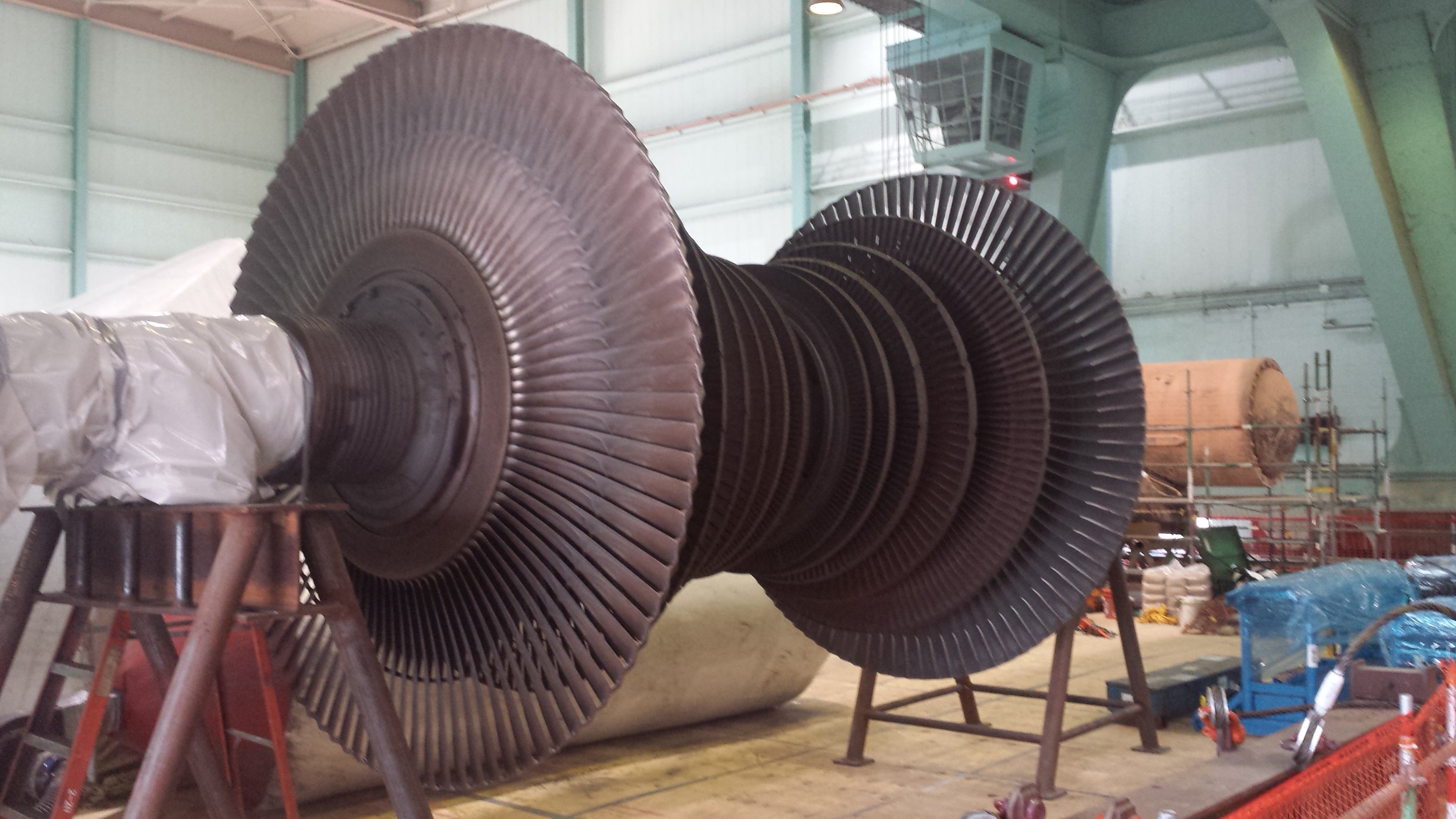 "You can tell a Finn but you can't tell him much" (youcantellafinn)
"You can tell a Finn but you can't tell him much" (youcantellafinn)
02/24/2015 at 08:14 • Filed to: powerlopnik, turbine blades, planelopnik
 4
4
 14
14
 "You can tell a Finn but you can't tell him much" (youcantellafinn)
"You can tell a Finn but you can't tell him much" (youcantellafinn)
02/24/2015 at 08:14 • Filed to: powerlopnik, turbine blades, planelopnik |  4 4
|  14 14 |
This is an interesting video GE put together for one of their latest gas turbine power generators. What got me at the end is how small the power generator is compared to the emission control equipment on the exhaust side. And since I haven't yet finished my first cup of coffee it had a little bit of the turbo-encabulator vibe going.
One of the really cool things that they mention is the !!!error: Indecipherable SUB-paragraph formatting!!! turbine blades. These turbine blades are made of a nickel superalloy and the mold is designed so that the blade is composed of a single crystal.
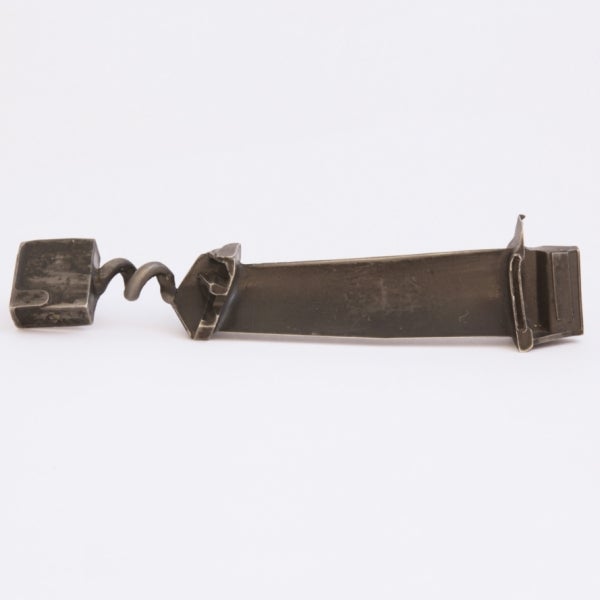
If you take a look at the blade to the left it is an unfinished casting. The rectangular block and the spiral (called a pigtail) are not part of the finished blade. When the metal is poured into the mold the far end of the block is cooled first, so that is where the metal begins to solidify. As the metal solidifies it starts to form crystals that line up with the axis of the turbine blade. The pigtail basically chokes off all those parallel crystals so that only one crystal makes it into the turbine blade. Once the blade has completely solidified the spiral and block will get machined off of the end.
Here is a representation of what that looks like. In this picture each color represents a crystal. By the time the metal has solidified through the pigtail there is only a single crystal left in the finished part.
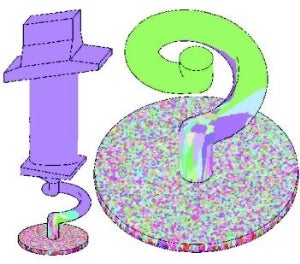
Making the blades out of a single crystal gives them a high creep strength that is needed to withstand the high temperatures and loads that the blades see in the high pressure turbines. As a metal structure has a load applied to it when it is heated the metal will creep. This is a slow deformation over time. In a jet engine this will eventually lead to catastrophic failure if the creep allows the turbine blade to make contact with other parts.
To make this go planelopnik have a couple of Rafales aboard the USS Harry Truman. The Rafales use single crystal HPT blades.
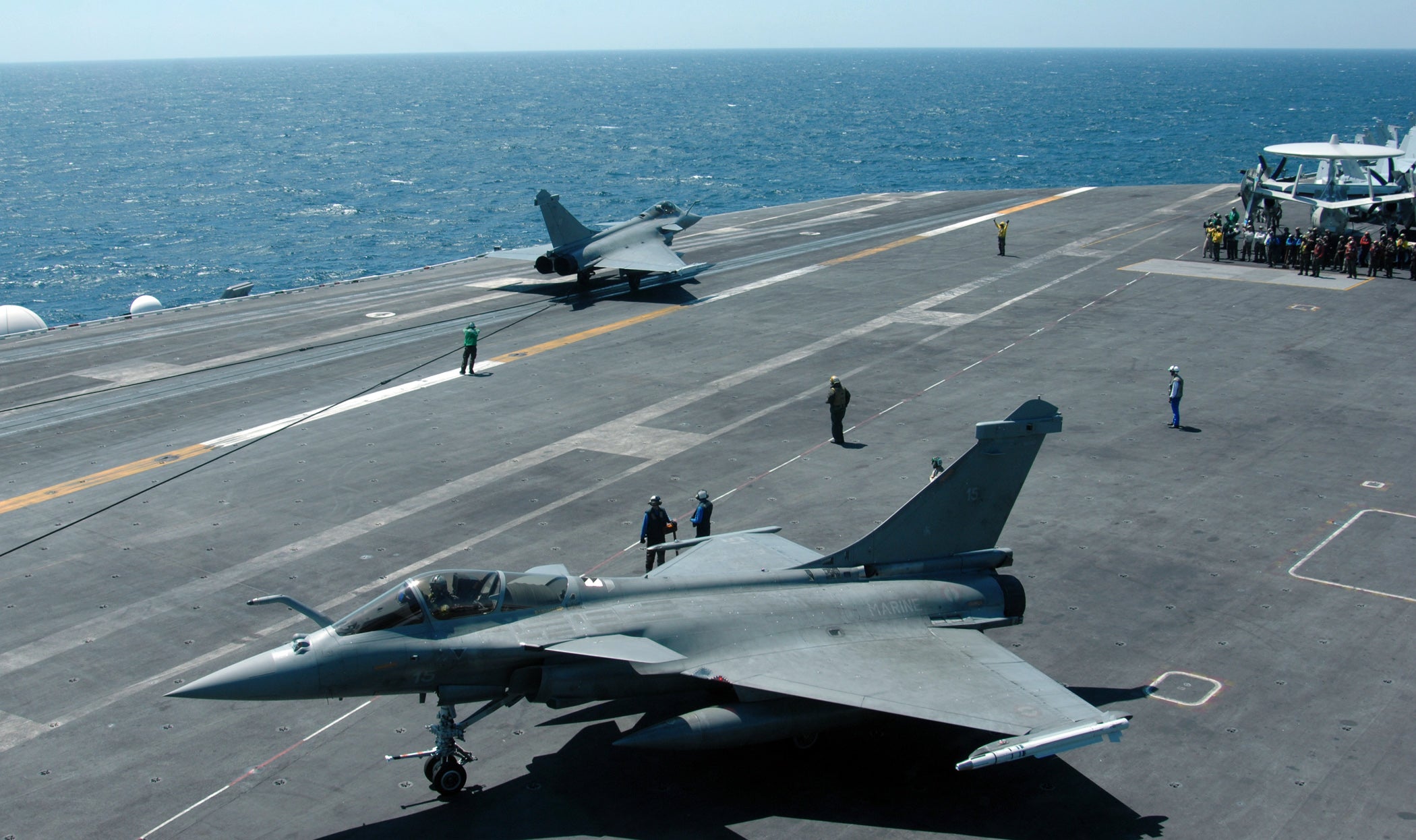
 GTI Sprinks
> You can tell a Finn but you can't tell him much
GTI Sprinks
> You can tell a Finn but you can't tell him much
02/24/2015 at 08:18 |
|
dig the hell out of this mostly for the materials science post. because fuck yeah materials science.
 Snuze: Needs another Swede
> You can tell a Finn but you can't tell him much
Snuze: Needs another Swede
> You can tell a Finn but you can't tell him much
02/24/2015 at 08:38 |
|
Gas turbines are amazing.
I deal with them and diesel engines for ship propulsion and it always blows my mind. For example, a high performance 16 cylinder marine diesel like a Fairbanks PA6B weighs 78 metric tons (172,000 lbs) and make 7200hp. A Rolls Royce MT30 gas turbine weighs 6.5 metric ton (14,300 lbs) and makes 48,000hp! That's over 6.5x more power for less than 1/10th the weight.
The only problem is their extremely limited powerband.
 You can tell a Finn but you can't tell him much
> Snuze: Needs another Swede
You can tell a Finn but you can't tell him much
> Snuze: Needs another Swede
02/24/2015 at 09:14 |
|
Out of curiosity, are the turbines rated for torque? Because intuitively it seems like they would make high HP but low torque where a big diesel will not make much HP but will make huge amounts of torque. It seems that turbines would be a good fit for electric propulsion where diesels would make for a much better direct drive option.
Outside of the output differences I've heard that gas turbines are very thirsty when it comes to boat propulsion. How do they rate efficiency for ship propulsion? Is it gph, mpg, gph/ton? And how do turbines and diesels compare when it comes to efficiency in terms of propulsion?
 You can tell a Finn but you can't tell him much
> GTI Sprinks
You can tell a Finn but you can't tell him much
> GTI Sprinks
02/24/2015 at 09:21 |
|
Yeah, that was the part that jumped out at me as making the video worth posting. My knowledge of single crystal casting is basically limited to what I posted. At university they talked about it for a few minutes in one of my classes and it was a total mind blown type of a moment for me that day. The progression from standard castings to directionally solidified to single crystal as the creep strength requirements increased is pretty cool. I meant to throw in this picture but forgot in the original post. The article it came from was a neat overview of why they came about.
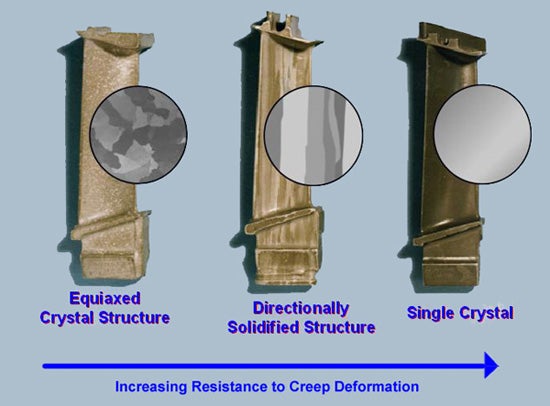
As an added bonus I came across a pdf from Rolls Royce talking about materials science in their jet turbines.
 Cé hé sin
> You can tell a Finn but you can't tell him much
Cé hé sin
> You can tell a Finn but you can't tell him much
02/24/2015 at 09:32 |
|
Lengthy research ( a minute on Google) tells me that a turbine engine used only to drive a propeller has a thermal efficiency of about 30% whereas a marine diesel has something like 50%.
So a turbine is much less efficient and you're not going to see one in a bulk carrier anytime soon.
 BorkBorkBjork
> You can tell a Finn but you can't tell him much
BorkBorkBjork
> You can tell a Finn but you can't tell him much
02/24/2015 at 10:08 |
|
That back-end is a boiler, not an emissions control setup. These are called "Combined Cycle" power plants. First you burn the natural gas in the turbine and use its energy from expansion to generate torque (which directly drives a generator). Then you run the exhaust through a convection boiler to use the heat from combustion to generate steam, which drive a steam turbine. The whole process is very efficient, so these plants are popping up everywhere. Big problem is that they are not conducive to typical types of emissions control (specifically for NOx), and they cannot run as long between outages as a traditional boiler-only power plant.
 Snuze: Needs another Swede
> You can tell a Finn but you can't tell him much
Snuze: Needs another Swede
> You can tell a Finn but you can't tell him much
02/24/2015 at 11:45 |
|
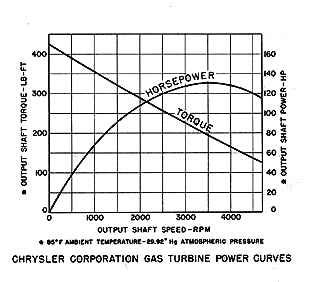
Somewhat counter-intuitively, a gas turbine develops very high torque at very low RPM. This curve was actually from the old Chrylser turbine car, but it's pretty much representative of all gas turbines.
Gas turbines are a good fit for constant speed, constant load operations where you can size them to work in their most efficient range. They are also great for warships because of their high power density, relative simplicity, and reduced maintenance requirements.
When looking at ship propulsion efficiency, the first think you typically look at is specific fuel consumption, which is measured in lbs/hp-hr or g/kW-h. Basically how much fuel you need (mass flow in lbs or grams) to make 1HP (or kW) for 1 hour. Diesel engines in general range from 155 - 210 g/kW-h, with the low end being the enormous 2-stroke inline 12's used in cargo ships while the higher end being something like a VW TDi in a car. Gas turbines are typically around 200 - 250 g/kW-h, so really not that far off. Another thing we look at is power density, which is hp/lb or kW/kg. Gas turbines typically make 5 to 6 kW/kg. Marine diesels have a far, far lower power density, typically on the order of 0.05 to 0.03 kW/kg. Sometimes thermal efficency is a consideration, which is how well the engine converts the chemical energy of the fuel into mechanical energy. Gas turbines are usually around 30 to 40%, diesels are typically 40 to 50%.
At the end of the day you have to pick the best powerplant to suit the mission profile. Supertankers and massive containerships are already hundreds of thousands of tons, so having a 2300 ton engine isn't a big deal. And these are for shipping, where time and efficiency are money, so a low speed diesel is perfect. You get enough power to make reasonable speed across the ocean while minimizing your operating costs.
Military vessels require more speed for rapid response to conflicts around the globe. You're also looking at much smaller ships, on the order of 10,000 tons, so every ton counts. Also, during the Cold War era when defense budgets were enormous, fuel wasn't really an issue, so gas turbines made the most sense. As alluded to earlier, gas turbines are only efficient over a narrow window of operating speeds, you don't see any benefit in running them slower, you're burning almost the same fuel to make less power. So in military craft they are typically operating at full tilt almost all the time. Ship speed is controlled by adjusting the pitch of the screws.
Also, these days, with shrinking defense budgets, the Navy is looking at hybrid power plants for its ship. Conserving fuel reduces costs, and also reduces the logistical burden. The LCS, for example, has 2 diesels for low speed ops, and 2 gas turbines for higher speed ops. The DDG1000 uses 2 large electric motors driven by a combination of gas turbine generators and diesel generators. So the right size generators can be selected depending on the ships electrical and propulsion requirements.
 Snuze: Needs another Swede
> Cé hé sin
Snuze: Needs another Swede
> Cé hé sin
02/24/2015 at 11:52 |
|
What's really more telling is specific fuel consumption (lbs/hp-hr or g/kW-h). Diesels range from 155 to 210 g/kW-hr, and actually get more efficient as the engine grows in size. Gas turbines range from 200 to 260 g/kW-hr.
Also, looking at power density, gas turbines can produce 5 to 6 kW/kg while diesels produce < 0.1 kW/kg.
You're right though, you'd never see a gas turbine in a bulk carrier. They are already hundreds of thousands of tons so weight is not an issue, and you want to maximize your efficiency to increase profits, so the diesels are a natural choice.
For a warship, you want speed and reliability, plus you're talking about vessels in the 10's of thousands of tons range, so weight means a lot more. So the gas turbine is a natural choice, especially 30 years ago during the cold war when defense budgets were bottomless. These days warships are moving to hybrid plants, retaining the turbines for when speed is necessary, but using smaller diesels or electric drives to cruise efficiently at slower speeds.
 You can tell a Finn but you can't tell him much
> Snuze: Needs another Swede
You can tell a Finn but you can't tell him much
> Snuze: Needs another Swede
02/26/2015 at 08:40 |
|
Thanks for the info, that is some cool stuff. I didn't realize how close a turbine was to diesel efficiency in terms of specific fuel consumption. I hadn't really thought about the size and weight differences between the two power plants either. It makes a lot of sense that you don't want a 2300 ton power plant on a 10,000 ton ship.
Last fall I got to tour the Enstrom Helicopter plant in Menominee Michigan. They use the Rolls Royce M250 turbine in one of their models. They are amazingly tiny and lightweight considering the power that they put out. The crazy thing is that they are belt drive.
On a military ship how do they absorb excess power? Do they use it to power electrical systems or does it just get dumped as waste heat?
 Snuze: Needs another Swede
> You can tell a Finn but you can't tell him much
Snuze: Needs another Swede
> You can tell a Finn but you can't tell him much
02/26/2015 at 09:10 |
|
Those helicopter turbines are very compact. The Y2K superbike used one, it might have been an MT250, it was like 90lbs and made 320hp or something like that. I worked in Naval aircraft support for a while back when I was enlisted and we used to have the turbines for the M-53 Sea Stallions. If you've never seen one in person, they are ENORMOUS... and powered by 2 (relatively) tiny little turbines.
On military ships, the excess power is dumped as waste heat and used to beat the water harder. Reversing gears are big, complicated, and another failure point, so instead we use variable pitch screws (called CPPs in military jargon, Controllable Pitch Propellers). The blades on the screw can rotate almost 180 degrees. So at top speed they are in their most efficient position, so almost all the power gets converted to thrust (minus losses of course). To slow down, you just rotate the blades to a less efficient position - the turbine runs at the same speed, you're just turning less power into thrust and beating the water up more. To reverse, you just spin the blades around 180 degrees so the thrust is reversed.
As of right now there's really no mechanism in place to recover waste heat. But there has been a recent push to increase efficiency, and that is one possibility. I think more likely you'll see a move towards IPS (Integrated Power Systems), which is like hybrid drive for a ship. As I mentioned before, the DDG1000 class uses this, with an array of diesel and turbine generators of different power levels, and 2 large electric motors for propulsion, so they can always pick the most efficient setup. They has also been some investigation into turbines that function as both propulsion and electrical generators, though I'm not sure if any ships are currently using that.
 You can tell a Finn but you can't tell him much
> Snuze: Needs another Swede
You can tell a Finn but you can't tell him much
> Snuze: Needs another Swede
02/26/2015 at 11:53 |
|
That is an ingenious way to control the pitch. Simple and effective.
I wouldn't be surprised to eventually see them go to electric propulsion. Azipods seem like they would have a lot of advantages in terms of manueverability. These ones even appear to have variable pitch propellers. Since Wikipedia tells me I need to attribute the photo - "Siemens Schottel Propulsor" by Siemens AG. Granted you probably don't need the maneuvering advantages once you're in blue water, but for a littoral ship they would probably offer a lot of advantages.
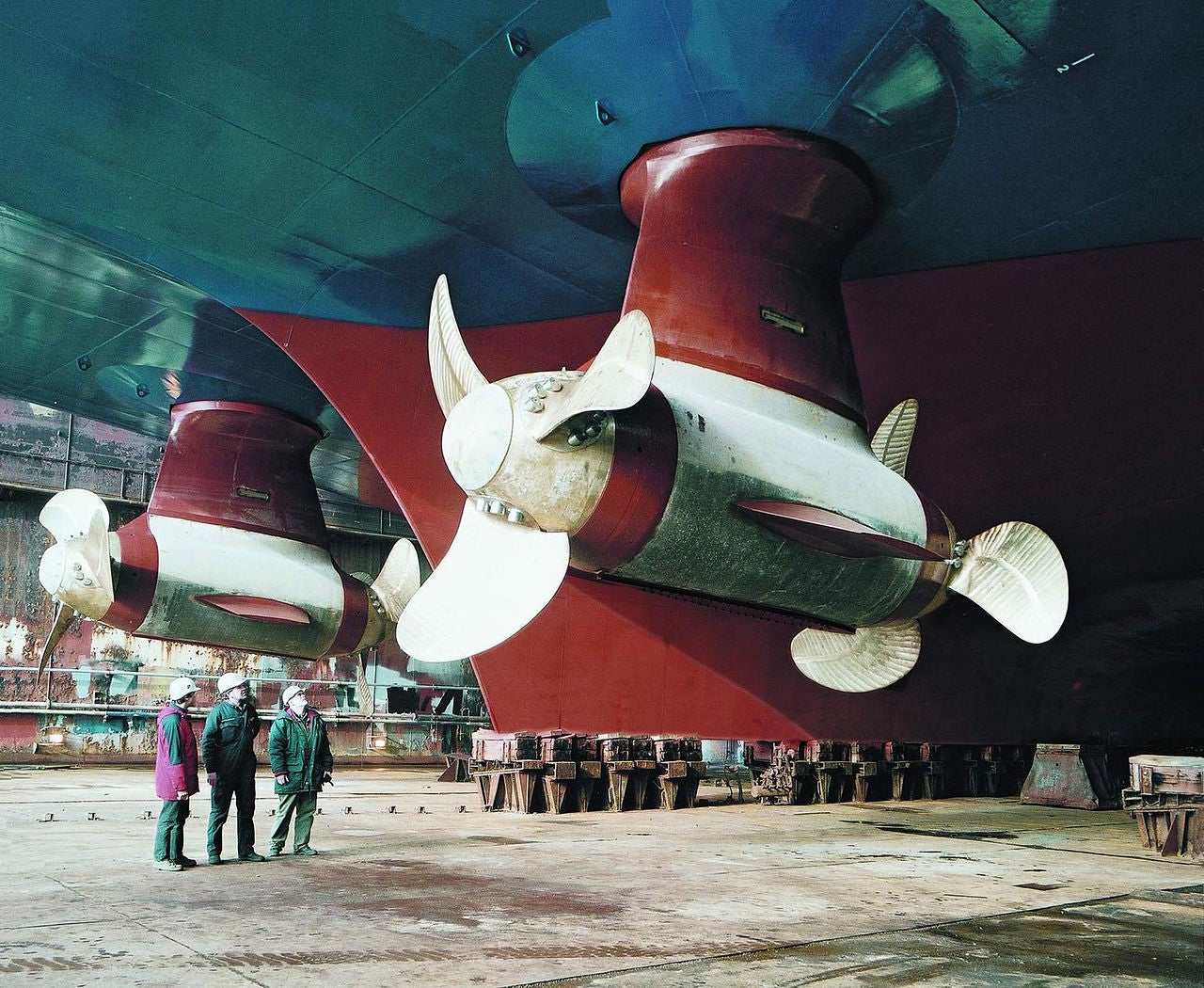
 Snuze: Needs another Swede
> You can tell a Finn but you can't tell him much
Snuze: Needs another Swede
> You can tell a Finn but you can't tell him much
02/26/2015 at 12:34 |
|
Wow! Those are really cool. I believe they wanted to do something similar on the DDG1000 class, but they rejected it as too high risk. So they tried to do Permanent Magnet Motors, but those had some major issues so they dropped them and went for good ol' induction motors.
 You can tell a Finn but you can't tell him much
> BorkBorkBjork
You can tell a Finn but you can't tell him much
> BorkBorkBjork
02/26/2015 at 13:21 |
|
Thanks for the info. I glanced at your response on my phone the other day and didn't feel like typing on a phone. I assumed they are emissions scrubbers because they look vaguely similar in footprint to some of the stuff on coal fired plants, but I'm not too familiar with power plant layouts and equipment outside of some generalities.
 BorkBorkBjork
> You can tell a Finn but you can't tell him much
BorkBorkBjork
> You can tell a Finn but you can't tell him much
02/26/2015 at 14:14 |
|
Well let me know if you need any more info, I build these things for a living. I mostly work on the steam-side of things.
Here's a Low-Pressure steam turbine from one of my projects, an emissions retrofit on a Natural Gas unit.
